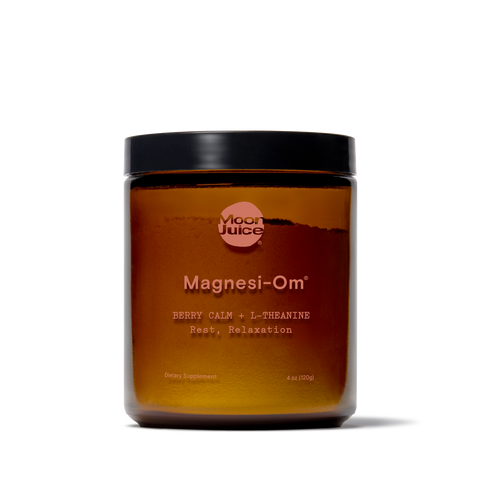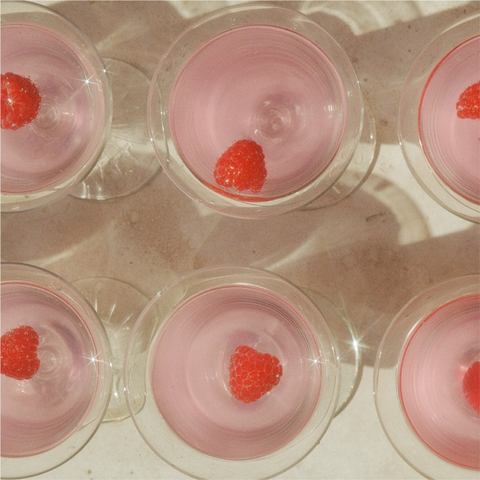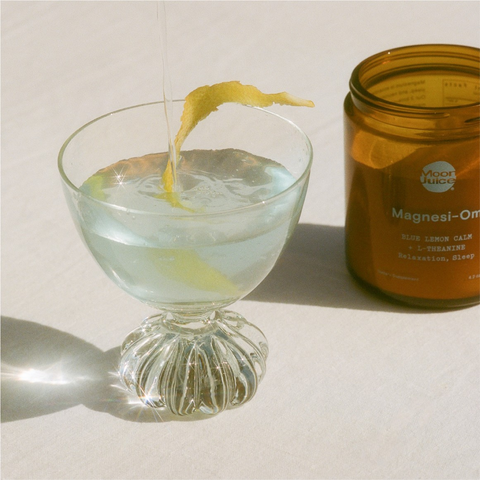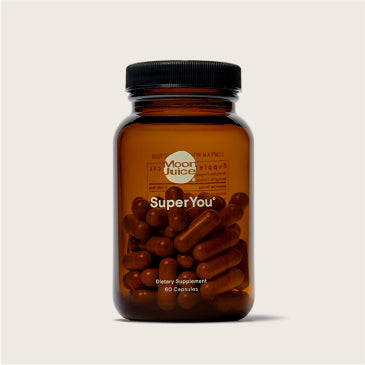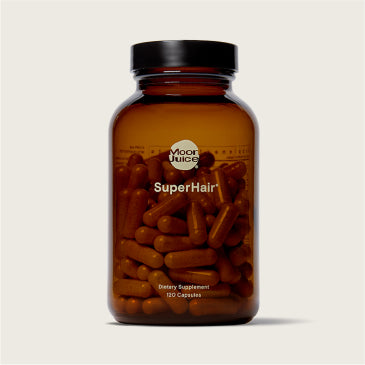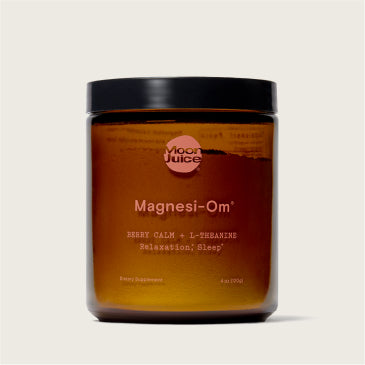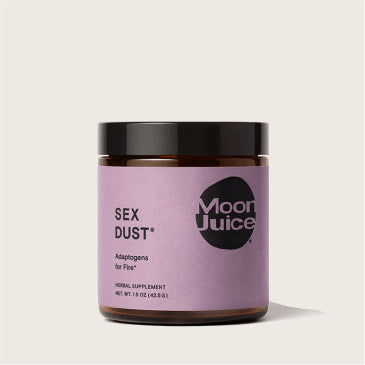It’s one thing to know that vitamins and minerals are good for your health, but another to know why you need certain ones in particular. Take, for example, Magnesium. Every cell in the human body requires Magnesium to function. The mineral is also prized for its many benefits for brain health, digestive regularity, sleep, and beyond. However, an estimated 50 percent of the US population is deficient. While it’s not a bad idea to add Magnesium-rich foods into your eating plan, you’ll be all the wiser to find ways to better absorb Magnesium, too.
So, what helps absorb Magnesium? Ahead, discover why you’ll actively want to increase Magnesium absorption to begin with. And later: 8 of the best ways to absorb Magnesium via simple but effective dietary and lifestyle tips.
Why Should I Try to Increase Magnesium Absorption?
Low Magnesium levels can be attributed to dietary gaps, soil depletion of modern food crops, and a lack of bioavailability of certain types of Magnesium. Some health conditions and medicines can also contribute to chronically low Magnesium levels.
In addition, a 2021 review in the journal Nutrients notes that Magnesium metabolism can decline over time due to impaired intestinal absorption. Certain foods and nutrients also interfere with Magnesium absorption. Essentially, this means that even if you think you’re getting enough through Magnesium-rich foods alone, your body won’t accept the mineral as readily. You could end up missing out on its health benefits and potentially increase the risk of a deficiency.
Potential signs of Magnesium deficiency include:
- Brain fog
- Stress
- Low mood
- Poor sleep
- Fatigue
- Headaches
- Muscle cramps
- PMS
- Constipation
- Blood sugar imbalances
To swap risks for rewards, learn how to increase Magnesium absorption with the tips below.
Consume a Balanced Diet With Magnesium-Rich Foods
While a few factors make it more challenging to ensure proper Magnesium balance from food, you should still consume them for extra Magnesium. Not only will they offer Magnesium but also many other nutrients to promote a spate of additional wellness wins. Better yet, if you nourish yourself with a diverse plant-forward diet, there’s a good chance you’re already eating a solid amount of foods rich in Magnesium.
Per a 2018 review in the journal Nutrients, the best Magnesium-rich foods include but aren’t limited to:
- Almonds
- Bananas
- Black beans and soybeans
- Broccoli
- Cashews
- Flaxseed
- Pumpkin seeds, sesame seeds, and sunflower seeds
- Spinach
- Sweet corn
- Tofu
Fun fact for those with a sweet tooth: Dark chocolate just so happens to be a good source of dietary Magnesium. Per the USDA, an ounce (one square) of dark chocolate with 70- to 85-percent cacao offers 65 mg of the mineral.
The National Institutes of Health lists the RDA for Magnesium as 310 to 360 mg for adult women and 400 to 420 mg for adult men. (During pregnancy, the RDA increases to 350 to 400 mg.) In perspective, a satisfying square of dark chocolate a day could provide around 15 to 20 percent of your daily needs. Paired with the other fresh foods above — as well as a bioavailable Magnesium supplement, as needed — you’ll be in a good place to ensure your daily intake is where it should be.
Ensure Adequate Vitamin D Intake
Vitamin D and Magnesium are among the most common nutrient deficiencies today, yet both are crucial for countless aspects of your well-being. The two are also complementary: According to a 2018 review in the International Journal of Endocrinology, Vitamin D3 can stimulate intestinal Magnesium absorption. At the same time, Magnesium is required to metabolize Vitamin D in the liver and kidneys, as well as transport it in serum.
People with low Magnesium and/or Vitamin D levels can benefit from supplementing with both micronutrients, and it’s generally safe to take both at the same time. (Note: It’s best to consult a health professional before starting any new supplement regimen.)
While your physician can run a blood test to gauge your Vitamin D levels, it’s more challenging to get a precise read of your Magnesium status since your body takes the mineral from the cells when it’s running low. For this reason, it’s crucial to be mindful of the signs of deficiency outlined above, know if your diet contains enough foods with the mineral, and assist Magnesium absorption in other ways.
Manage Phytic Acid
Phytic Acid is an anti-nutrient, which means that it blocks the absorption of certain nutrients. Per a 2015 review in the Journal of Food Science and Technology, Phytic Acid inhibits not only Magnesium, but also other minerals including Calcium, Iron, Manganese, and Zinc.
While the term ‘anti-nutrients’ might sound harmful, the truth is that they’re packed in many nutritious foods. For instance, Harvard Health lists whole grains, legumes, seeds, and some nuts as sources of Phytic Acid — some of which, in fact, will also contain dietary Magnesium themselves.
Although you shouldn’t fear foods with Phytic Acid, you can take care to hack your intake and increase Magnesium absorption by:
- Avoiding eating Magnesium-rich foods (or taking supplemental Magnesium) and anti-nutrient foods at the same time
- Soaking, sprouting, or boiling Phytic Acid foods before consuming them, which will remove or deactivate the anti-nutrient
Note: Most people — especially those who eat an abundance of plants and lean animal foods — typically don’t need to worry about limiting Phytic Acid foods. It’s also uncertain how much Phytic Acid will actually hinder absorption of minerals like Magnesium. However, those who are low in Magnesium, have other mineral deficiencies, or adhere to vegan diets may need to take greater care to reduce Phytic Acid in their diet.
Limit Calcium-Rich Foods
Calcium is famed for its ability to build and maintain strong bones. It’s also required to promote proper function of your heart, nerves, and muscles. As beneficial as the mineral is and how crucial it is to get enough of it in your diet (at 1,000 to 1,200 mg per day for most adults), it doesn’t pair well with Magnesium.
Research shows that Calcium competes with Magnesium for intestinal absorption and transport. For that reason, one of the best ways to get an adequate intake of Magnesium is to consume it separately from Calcium supplements and Calcium-rich foods, which include:
- Yogurt
- Sardines
- Fortified milks, juices, and cereals
- Tofu
- Salmon
As is the case with Phytic Acid, you’ll simply want to separate your intake of these foods with dietary sources of Magnesium (rather than abstaining from these foods completely) in order to help absorb the essential mineral.
Avoid Too Much Caffeine or Alcohol
While a cup or two of coffee per day is generally safe for most people, those concerned about their Magnesium levels should take extra care to avoid getting too much caffeine in their system. The more caffeine you consume, the less Magnesium you’re able to absorb. Since most coffee drinkers sip up on a daily basis, this could contribute to a gradual depletion of Magnesium levels over time, which could result in a deficiency.
Alcohol is yet another substance that can hinder your ability to absorb Magnesium. Research shows a correlation between an increase in serum alcohol levels and decreased serum Magnesium levels. Per a 2020 study published in the journal Alcohol and Alcoholism, alcohol-dependent patients with mild liver injury demonstrated low serum Magnesium concentrations, illustrating the negative impact of consistent alcohol intake on Magnesium status.
As such, limiting your intake of caffeine and alcohol is among the best ways to absorb Magnesium and promote Magnesium status over time.
Maintain Good Digestive Health
Keeping your gut in great shape is one of the best things you can do for your total health, full stop. Doing so will promote everything from immune function and a clear complexion to a balanced mood — and it’s also a surefire way to increase Magnesium absorption. Magnesium malabsorption is common in people with gut imbalances and digestive issues, as symptoms like diarrhea and poor absorption of fats can deplete this mineral in the body.
One of the best ways to support gut health and increase Magnesium absorption is to boost your intake of dietary fiber. Per a 2022 study published in the journal Scientific Reports, when gut bacteria digestive fiber, it consequently stimulates intestinal mineral absorption.
Aim to eat the recommended amount of fiber daily — which is 25 g for women and 38 g for men, according to the Academy of Nutrition and Dietetics — by enjoying fiber-rich foods including but not limited to:
- Berries
- Pears
- Apples
- Avocado
- Artichokes
- Broccoli
- Black beans
- Almonds
Tip: When eating fruits, keep the skin on whenever possible since it packs the bulk of dietary fiber. Plus, as you’re revving up your fiber intake to increase Magnesium absorption and promote gut health, don’t forget to sip on plenty of H2O to prevent digestive distress.
Choose a Magnesium Supplement With Better Absorption
To hack your Magnesium absorption game via supplements, your best bet is to opt for the most bioavailable types of oral Magnesium. Not all forms of the essential mineral have the same potency and perks, either, so when looking into Magnesium supplementation it pays to be selective.
If you want to increase Magnesium levels and be sure that you’re getting as much as possible from your intake, a Magnesium powder supplement like Magnesi-Om® is a safe bet. One serving packs a total of 310 mg across 3 bioavailable forms of Magnesium in a Chelate blend (meaning it is a more stable form of Magnesium), each of which has unique health benefits:
- Magnesium Gluconate supports muscle relaxation*
- Magnesium Acetyl Taurinate promotes cognitive function and mood*
- Magnesium Citrate encourages regular bowel movements*
Magnesi-Om® also contains nootropic L-Theanine, which promotes alpha-wave brain activity to boost alertness and mental clarity. The result: a sense of calm and the promotion of healthy cognitive aging.*
This Magnesium powder is available in delicious Berry and Blue Lemon flavors. Mix 1 tsp into water and enjoy as you begin your bedtime wind-down routine (or whenever you need a little something special to unstress).

Stay Hydrated
To keep your mind and body in good shape, staying hydrated is just as crucial as eating a balanced diet, exercising, managing stress, and sleeping well. Getting enough H2O can also complement Magnesium absorption in several ways.
Depending on the source, some water may naturally contain minerals like Magnesium, which will count towards your RDA. In addition, your body may better absorb Magnesium when consumed via liquids.
In your quest to increase Magnesium absorption, take care to sip on plenty of water daily — and get 2-for-1 benefits by mixing a supplemental Magnesium powder like Magnesi-Om® into a glass of H2O.
Sources
- https://lpi.oregonstate.edu/mic/micronutrient-inadequacies/overview
- https://pubmed.ncbi.nlm.nih.gov/33573164/
- https://www.ncbi.nlm.nih.gov/pmc/articles/PMC6316205/
- https://fdc.nal.usda.gov/fdc-app.html#/food-details/170273/nutrients
- https://ods.od.nih.gov/factsheets/Magnesium-HealthProfessional/
- https://www.ncbi.nlm.nih.gov/pmc/articles/PMC5926493/
- https://www.ncbi.nlm.nih.gov/pmc/articles/PMC4325021/
- https://www.hsph.harvard.edu/nutritionsource/anti-nutrients/
- https://www.mayoclinic.org/healthy-lifestyle/nutrition-and-healthy-eating/in-depth/calcium-supplements/art-20047097
- https://ods.od.nih.gov/factsheets/Calcium-HealthProfessional/
- https://www.ncbi.nlm.nih.gov/pmc/articles/PMC2082111/
- https://pubmed.ncbi.nlm.nih.gov/1748234
- https://academic.oup.com/alcalc/article/55/2/164/5734241
- https://pubmed.ncbi.nlm.nih.gov/36329098/
- https://www.eatright.org/health/essential-nutrients/carbohydrates/easy-ways-to-boost-fiber-in-your-daily-diet





